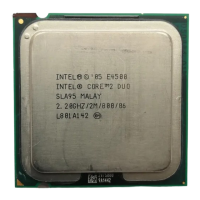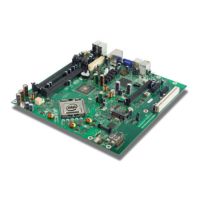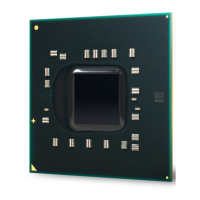Errata
Intel
®
Core™2 Extreme Processor X6800 and
Intel
®
Core™2 Duo Desktop Processor E6000 and E4000 Sequence 25
Specification Update
Workaround: Use the IRET instruction to return from a system call, if RF flag has to be set
after the return.
Status: For the steppings affected, see the Summary Tables of Changes.
AI7. General Protection Fault (#GP) for Instructions Greater than 15
Bytes May be Preempted
Problem: When the processor encounters an instruction that is greater than 15 bytes in
length, a #GP is signaled when the instruction is decoded. Under some
circumstances, the #GP fault may be preempted by another lower priority
fault (e.g. Page Fault (#PF)). However, if the preempting lower priority faults
are resolved by the operating system and the instruction retried, a #GP fault
will occur.
Implication: Software may observe a lower-priority fault occurring before or in lieu of a
#GP fault. Instructions of greater than 15 bytes in length can only occur if
redundant prefixes are placed before the instruction.
Workaround: None identified.
Status: For the steppings affected, see the Summary Tables of Changes.
AI8. Pending x87 FPU Exceptions (#MF) Following STI May Be Serviced
Before Higher Priority Interrupts
Problem: Interrupts that are pending prior to the execution of the STI (Set Interrupt
Flag) instruction are normally serviced immediately after the instruction
following the STI. An exception to this is if the following instruction triggers a
#MF. In this situation, the interrupt should be serviced before the #MF.
Because of this erratum, if following STI, an instruction that triggers a #MF is
executed while STPCLK#, Enhanced Intel SpeedStep Technology transitions
or Thermal Monitor events occur, the pending #MF may be serviced before
higher priority interrupts.
Implication: Software may observe #MF being serviced before higher priority interrupts.
Workaround: None identified.
Status: For the steppings affected, see the Summary Tables of Changes.
AI9. The Processor May Report a #TS Instead of a #GP Fault
Problem: A jump to a busy TSS (Task-State Segment) may cause a #TS (invalid TSS
exception) instead of a #GP fault (general protection exception).
Implication: Operation systems that access a busy TSS may get invalid TSS fault instead
of a #GP fault. Intel has not observed this erratum with any commercially
available software.
Workaround: None Identified.
Status: For the steppings affected, see the Summary Tables of Changes.

